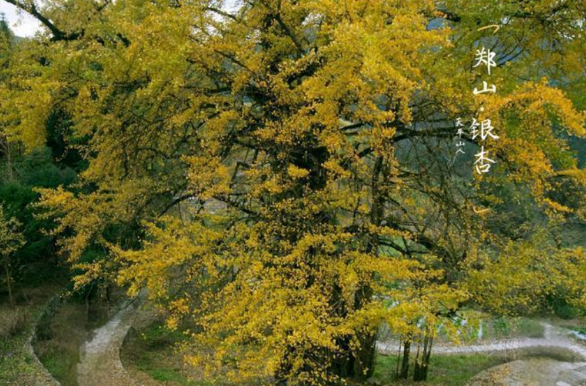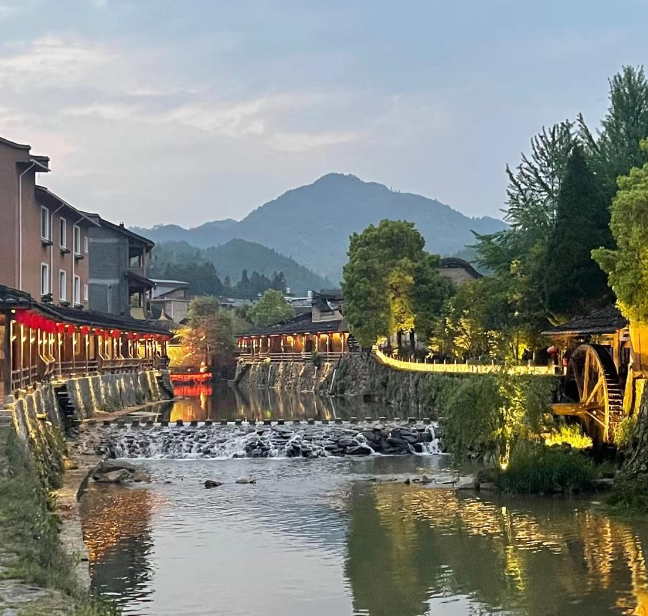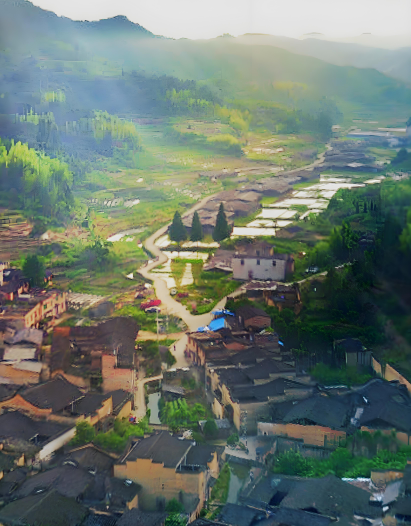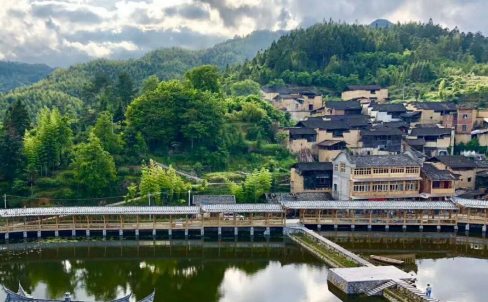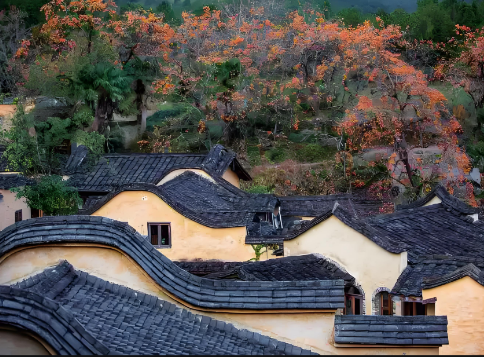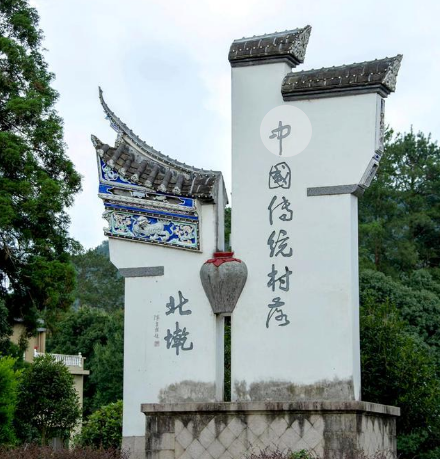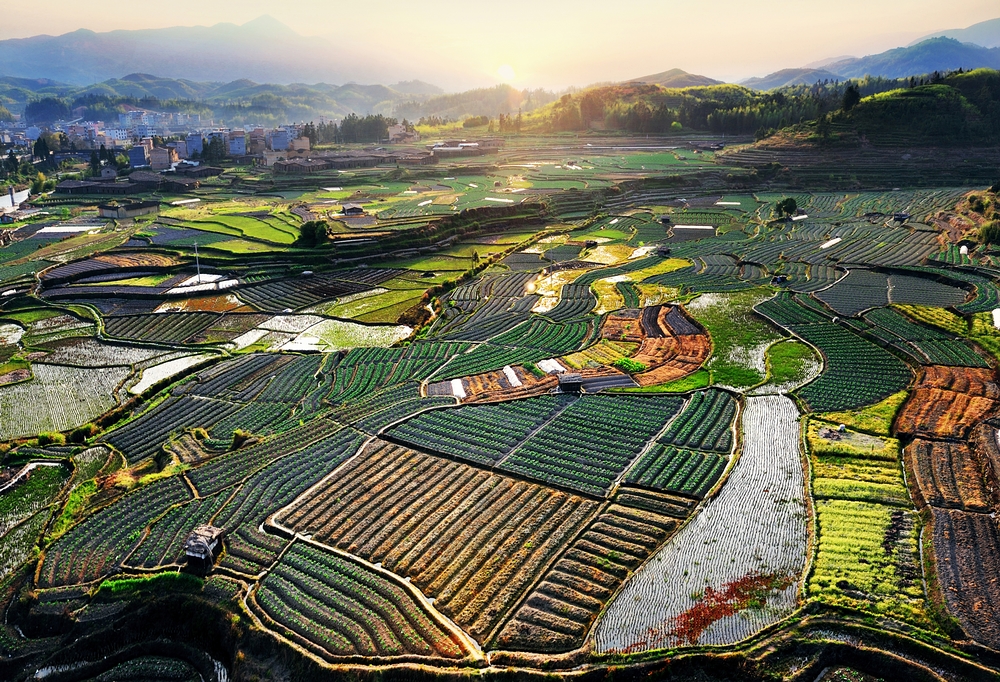Jitou Village
Jitou Village is an administrative village under the jurisdiction of Tangkou Town, Pingnan County, Fujian Province. It is located 4.5 kilometers east of Pingnan County, along Provincial Highway 303. Fengtou Village was founded in the third year of the Qianfu reign of Emperor Xizong of the Tang Dynasty (876 AD), and has a history of more than a thousand years. It has been the leading place of the "Four Great Book Villages" in Pingnan since its establishment in the Qing Dynasty, and was once known as the "Good Fengtou of Pingnan". With a total area of 31 square kilometers, Jitou Village has a registered residence population of more than 3000 (including Batling at Chengguan), a permanent resident population of more than 500, and more than 1000 overseas Chinese and compatriots from Hong Kong, Macao and Taiwan at home and abroad. It is one of the largest villages in Pingnan County. The local culture such as imperial examinations, folk customs, drama, martial arts, and cuisine, as well as local historical and cultural relics in Fengtou Village, are well-known in some counties and cities in Pingnan and northeastern Fujian, and have enjoyed the reputation of being the top of the four major book towns in Pingnan. There were more than 200 imperial examiners in the Ming and Qing dynasties, among whom there were Huang Tong who participated in the compilation of the Yongle Grand Ceremony of the Ming Dynasty, Zhang Fangju, Zhang Zhengyuan, the "great uncle and nephew" who were deeply concerned by Lin Zexu, and Zhang Zan, a member of the Chinese Revolutionary League who compiled the National Music Dictionary. This place is also known as the "hometown of drama", where four out of the seven local operas in Pingnan originated. At the same time, the martial arts culture of Huotou has a long history. As early as more than 200 years ago, the Iron Head Monk (Chen Yunqi) from Quanzhou Shaolin Temple, who fled, lived in seclusion at Ciyin Temple in the north of the village and taught martial arts there. Therefore, there is a saying that "Huotou martial arts are the best in northern Fujian", which has been passed down from generation to generation and retains the excellent tradition of martial arts practice.Historical and CulturalThis is a place where talents come from generations. During the Ming and Qing dynasties alone, there were over 200 imperial examination officials, including Huang Tong who participated in compiling the Ming Dynasty's "Yongle Encyclopedia", Lin Zexu's highly regarded "uncle and nephew two jinshi", and the "father son three gongsheng" scholarly family who was favored by the tree list. Nowadays, the trend of advocating reading in the book village is even stronger, and there are numerous family happy events such as "one school, two PhDs" that are talked about. The head of the family is still a "good head" in Pingnan.This is a rural area with a rich cultural heritage. In ancient times, it was a major transportation route from Jianning Prefecture to Funing Prefecture, Fuzhou Prefecture, and other places, serving as a midpoint between sea and land. Therefore, the glorious history has left many cultural elements for Huotou, which have been well preserved. Nowadays, walking into the village, historical relics and artifacts can be seen everywhere.The well preserved ancient residences, ancestral halls, temples, ancient tombs, ancient wells, ancient couplets, and ancient plaques of the Ming and Qing dynasties are all full of ancient charm and charm, evoking a sense of time reversal. Looking at the various ancient plaques engraved with words such as "Wenkui", "Wukui", "Husband and Wife of the Same Age", as a leader, why don't you feel proud of it? Looking at the more than ten Jiexiao Fangs that were built in less than a hundred years during the Qing Dynasty, don't you think as a modern person, why not feel a lot of emotion about it?In fact, there are more things worth rewarding for people in Huotou Village! Any ancient house, any section of ancient wall, any ancient alley, is full of the texture of crossing history. If explained by the elders in the village, the stories here will be like the water in the carp stream passing through the village, flowing endlessly, making people unable to help but sigh with a sense of antiquity.The head is open. Its historical position as a transportation hub naturally led it to embrace Confucian culture, Taoist culture, and even Christian culture. Today's otaku are not closed off either. As long as you are interested, wherever you go to see cultural relics, the owner will surely bring out something they consider a "family heirloom" with a calm smile, satisfy your desires, and even explain it to you. This is so different from the deeply rooted peasant consciousness since ancient times!In the folk culture festival held in the village, the head of Waterfall performed traditional martial arts, opera and other watchful skills, and displayed ancient tablets, ancient wutong tree couplets and other antiquities. Their open awareness left a deep impression on outsiders.Obtain honorsIn 2010, it was awarded the honorary title of the fifth batch of "Famous Historical and Cultural Villages in China" by the Ministry of Housing and Urban Rural Development and the National Cutural Heritage Administration.
Tangkou Village
Tangkou Village, Tangkou Town, Pingnan County, was founded in the early years of the Qingyuan period of the Song Dynasty (1195) and has a history of more than 810 years. Since its establishment, Pingnan has been the center of cultural and commercial activities throughout the county. The long history contains rich cultural relics and historical sites, with a strong accumulation of ancient culture, including ancient architectural culture, imperial examination culture, drama culture, and revolutionary sites.摄影:寿鹏Historical evolutionTangkou Village was originally under the jurisdiction of the Twenty Eight Capitals and Five Guarantees of Gutian. After the establishment of Pingnan County in February of the 13th year of the Yongzheng reign of the Qing Dynasty (1753), it was under the jurisdiction of the Three Capitals of Pingnan County. In the third year of the Republic of China (1914), the capital system was abolished, and the county was divided into three districts. Tangkou was under the jurisdiction of the Southern First District, and in 1937, the county was divided into three district offices. Tangkou is the location of the first district office. In 1940, the county established 12 townships, with Tangkou serving as the administrative center of Tangkou Town. In 1944, the 12 townships in the county were reorganized into 8 townships, with Tangkou being the administrative center of Tangji Township. After the establishment of the People's Republic of China in 1949, the county was divided into three districts, with Tangkou as the first district's administrative center. In 1951, the county was reorganized into four districts, with Tangkou as the third district's administrative center. In 1952, the county was divided into 6 districts, 3 towns, and 55 townships, with Tangkou still serving as the seat of the three districts. In 1955, the Third District was renamed as Tangkou District Office and a new seal was used. In 1958, the county was reorganized into five people's communes, with Tangkou serving as the seat of the Pioneer People's Commune. In 1961, the county was divided into 11 people's communes, with Tangkou serving as the seat of the Tangkou People's Commune. In 1984, the county established town and township people's governments, which have been the seat of the Tangkou Township People's Government to this day. On January 10, 2018, the People's Government of Fujian Province approved the revocation of Tangkou Township and the establishment of Tangkou Town in Pingnan County. After research, it was agreed that Pingnan County would revoke Tangkou Township and establish Tangkou Town, with the administrative area of the original Tangkou Township as the administrative area of Tangkou Town, and the government seat would remain unchanged.Natural conditionLingxia Creek and Bai Creek intersect in front of Tangkou Village to form Tangxi Creek. The water is blue and the pond is deep. There used to be a portrayal of the "wild rushing of the stream water, and the two streams flowing back and forth". The rainfall is abundant, the sunshine is sufficient, there is no severe cold in winter, no scorching heat in summer, and cool in autumn and summer. The annual average temperature is 15.5 ℃, and the climate is suitable for the growth of all things.Scale of villages and townsTangkou Village is the political, economic, and cultural center of Tangkou Township, with a total of 32 village groups, 912 households, and 4520 people. There are more than ten service units within the territory, including Tangkou Middle School, Tangkou School District, Township Health Center, Public Security Police Station, Forestry Station, Radio and Television Station, Agricultural Supply and Marketing, and Social Linkage Network, with over 500 employees and their families. In recent years, three major projects have been completed, including village road auxiliary construction, power grid renovation, and water supply, as well as the reconstruction projects of "Poqiu Bridge" and "Litan Bridge".Character styleTangkou Village is renowned for its talent pool and is known as one of the four successful candidates in the village. The art of sculpture and puppetry have also become famous in various placesIn the third year of the Qianlong reign of the Qing Dynasty, Zhou Daxun, a juren in Kaixian County, was appointed. In the 57th year of the Qianlong reign, Zhou Dajun passed the imperial examination, and in the 24th year of the Jiaqing reign, Zhou Fang passed the imperial examination. In the 23rd year of the Guangxu reign, there were 22 tribute students including Zhou Dianhui and Zhou Tianlin, Zhou Yongxiong, Zhou Shangfu, Zhou Daquan, Zhou Shangzao, Zhou Zhulian, Zhou Zhongwang, Zhou Ziqi, and 98 students. Zhou Jichou, a member of the "China Chinese Revolutionary League" at the end of the Qing Dynasty and the beginning of the Republic of China, Zhou Zhengbao, a puppet artist, Wei Dayou, a master sculptor, Zhou Qihong, a folk painter, Zhou Zhenping, a modern doctor, Zhou Huaqun, a senior engineer, Zhou Rongliang, Zhou Aihua, Zhou Cuiying and more than 40 other people are quite famous.Scenic Spots and Historical SitesTangkou Village has the most famous scenic spots and historical sites in the county, and has a provincial-level cultural relic protection unit called "Qiancheng Bridge". County level cultural relics protection units include the "Bajiao Pavilion", "Xiangfeng Temple", "Monument to the Northern Resistance of the New Fourth Army's Three Branches and Six Regiments", as well as the "Lin Gong Hall" of the Minping Guerrilla Army's combat command headquarters, the "Former Site of the Three Branches and Six Regiments of the New Fourth Army", and the "Girls' Residence". The "Husband's Palace" and "Three Saints' Lady Hall" were built in the 19th year of the Qianlong reign of the Qing Dynasty, and the former sites of the earliest Western medicine "Pan Meigu Hospital" and "Shuhua Women's School" in Pingnan, which were built in the late Qing Dynasty, are well preserved to this.1. The former site of the Sixth Regiment Headquarters of the Third Detachment of the New Fourth Army is located on Longchengang in Tangkou Village. Built in the first year of the Xuantong reign of the Qing Dynasty (1909), it covers an area of 2000 square meters. A two-story Ouzhou style building with brick and wood structure. In August 1986, Vice Chairman Ye Fei wrote a glorious historical document titled "Former Site of the Sixth Regiment Headquarters of the Third Detachment of the New Fourth Army" for the "Girls' Residence" during his inspection of eastern Fujian.2. Former site of Pan Meigu HospitalPan Meigu Hospital: Built in the second year of the Xuantong reign of the Qing Dynasty (1910), it is located in Longshenggang, Tangkou Village. It covers an area of 3.1 acres and has a construction area of 1192 square meters. The hospital originally had supporting buildings such as a gatehouse, a peace room, a dining hall, a toilet, and a firewood room. There is a wide playground inside, surrounded by green trees, with a peaceful environment and fresh and pleasant air. The main building of the hospital and the layout of the surrounding environment have a typical European style. The first Western Hospital founded by the Christian Church in Pingnan has a history of nearly a hundred years.Pan Meigu Hospital has internal medicine, surgery, operating room, laboratory, outpatient department, obstetrics and gynecology room, morgue, gatehouse, etc. There are over 60 iron frame beds, more than 10 nurses, and 3 doctors. The first one was Dr. Pan Meigu, the second one was Dr. Bing Shuhui, and the third one was Dr. Xu Zeshu. At that time, some villages near Pingnan, such as Jianou, Zhenghe, Zhouning, Gutian, etc. in neighboring counties, had patients coming for treatment.3. Former Site of Shuhua Girls' SchoolShuhua Girls' School: Located on Longshenggang in Tangkou Village, it was founded by the Anglican Church of China in 1913 and is a church school that relies on foreign subsidies. The school system includes kindergarten, four years of junior high school, two years of junior high school, and three years of junior high school. At that time, only junior high school was available, and only girls were accepted. Boarding was adopted, and there were 56 students that year, with the majority being children of believers. The four months were one semester, with eight classes per day. There were subjects such as "Bible Prayer, English, Chinese, Mathematics, History, Geography, Painting, Singing, and Physical Education".In the spring of 1925, the Anglican Church of China established Hua Girls' Junior High School on the basis of Shuhua Primary School, which was the earliest secondary school in Pingnan.Natural landscape1. The 'Natural Swimming Lake' is located at the confluence of two streams to the north of Tangkou Township. Built in the early 1990s. Covering an area of over 60 acres, with clear waters and birds flying and fish swimming, it is a great spot for people to swim, fish, relax and sightsee.2. The upstream of Litan Reservoir (Wangkeng Power Station Reservoir) starts from Shuiwei "Xidong" in Tangkou Village and ends at "Luping" in Anxi Village, covering an area of nearly a thousand acres. Along the way, the mountains and clear waters are beautiful, and the mountain flowers are brilliant. It is a water tourist attraction for people to enjoy yacht sightseeing and leisure fishing.3. Mirror Lake "is located in front of the ancestral hall of Tangkou Village, covering an area of as much as two acres. Every spring, the water rises and overflows, with hundreds of divine carp flying into the clouds and mist with the waves. The water recedes and returns to the lake, with two wells inside. The water is clear and pure, or turbid, and one well must also serve as two wells. There is a stream outside called "Jiuqu Creek" flowing by the lake, and downstream there is a small pond with a hidden red stone called "Stone Seal". It is said that if this seal appears, the village will be famous.4. Lingonggang "is located to the east and west of Tangkou Village. Although it is only 900 meters high, there are dozens of villages such as Baixi and Lifenglin that can be seen from the summit. There is a stele of "Zhongping Wang Lin Gong" located within a few hundred acres, with evergreen pine and bamboo trees, fragrant tea and fruits, and panoramic views of the two lakes to the southeast near the "Luping Reservoir". It is a cool spot with a clear breeze and bright moon. It once attracted many tourists to come for sightseeing.Cultural Activity Every year from the 11th to the 15th day of the first lunar month, Tangkou Village welcomes the Three Saints Milk, Chen Daniao, and the Dragon and Lion Dance to celebrate. The theater troupe performs for five or seven days to celebrate, and the villagers make their own "Fragrant Dragon", "Cloth Dragon", "Green Lion", and "Flower Lantern" to the accompaniment of drums and gongs. They visit every street and alley every night. On the evening of the 15th day, they enter the wedding and birthday celebration homes to sing poetry and speak good words. The families they go to welcome them with firecrackers, and they receive them with sugar, tea, wine, fruits, and give red envelopes.Every year on the fifteenth day of the sixth lunar month, which is known as the Half Year Festival, the village holds a dojo at Xiangfeng Temple forthree days. On the fifteenth night, the villagers carry torches and accompany monks and Taoists to various intersections in the village to offer vegetarian bread, clothing, and wealth to lonely souls and wild ghosts. In the late night, under the bridge of the house, there is a "release of Mongolian life" ceremony, also known as the "release of water lanterns", praying for peace and security in the village.Tangkou is located in Pingnan County, with mountainous terrain as the main feature, at an altitude of 760m, with an annual precipitation of 1770mm and about 136 rainy days per year. The abundant rainfall is suitable for the growth of various crops, with rice as the main grain crop and sweet potato as a supplement, and shiitake mushrooms and tea as the main economic crops, with fruits as a supplement. The total land area of the village is 27317.1 acres, including 3676.3 acres of arable land, 2033.1 acres of garden land, 17657.7 acres of forest land, 624.2 acres of industrial and mining areas in urban and rural areas, 197 acres of transportation land, 936.2 acres of water area, and 2192.6 acres of unused land. The main rivers in the area are Tangkou Creek, which flows from northwest to southeast and merges with Jinzao Creek, which flows from west to east in the south, and flows into Huotong Creek at a single bridge. The total water area of the two rivers is 2510.3 acres, indicating abundant water resources; The main meteorological disasters in Tangkou Village are floods and landslides. At the end of the year, there were 4357 mu of arable land, including 3927 mu of paddy fields, 2555 mu of dry fields, 6216 mu of crop sowing area, 5676 mu of grain sowing area, a total grain output of 2078.8 tons, 927 mu of tea area, and 38 tons of tea production. The villagers in the whole village have developed over 3000 acres of planting various fruits such as oil chestnuts, persimmons, peaches, etc. More than 4000 acres of tea are currently being grown. Planting trees, afforestation, and cultivating more than 2000 acres of bamboo. More than 500 households in the village planted 4 million tubes of shiitake mushrooms. Tangkou Village mainly develops tea processing and processing.Qiancheng BridgeLocated in Shuiwei, Tangkou Village. Founded during the reign of Emperor Lizong of the Southern Song Dynasty, it was once again recruited and built by scholar Zhou Daquan and others in the 25th year of the Jiaqing reign of the Qing Dynasty (1820). Stretching north-south, with a total length of 62.7 meters and a width of 4.9 meters, the bridge deck is 9.7 meters above the water surface. There are 40 levels of stone steps in the east and 15 levels in the west. One pier with two holes, the pier is in the shape of a boat, built of granite, and the tip of the pier is carved in the shape of a chicken head. Each hole has a span of 27.5 meters. The bridge house has 24 rooms and 99 columns, with hanging mountain eaves and upturned corners. There is a shrine in the bridge dedicated to the Five Manifestations of the Great Emperor. There are board chairs on both sides for pedestrians to rest. There are still wind boards on both sides to resist the invasion of wind and rain. The main ropes for building the bridge are Zhang Chengde and Zhang Chenglai from Ningyi, and the deputy ropes are He Kaifeng and He Naixing from Ningyi; The stonemason Ning Yi Zhang Cheng sent it. Ten meters away from the bridge, there is a stone archway from the fourth year of the Qianlong reign of the Qing Dynasty (1739), as well as octagonal pavilions, Lin Gong Temple, Xiangfeng Temple, and two dragon wells. Nearby, there is also a monument commemorating the northward resistance of the Sixth Regiment of the Third Division of the New Fourth Army against Japan. The Qiancheng Bridge, like a long rainbow lying on the waves, is magnificent and beautiful. The inscription in the bridge's history reads, "Standing tall in the sky, a rainbow spans a hundred feet; facing the deep, accumulating rocks, standing tall for thousands of years." This is the best portrayal of the bridge.At the southern end of the bridge, there are four stone tablets, three of which record the names and amounts of donors, and one is the Qiancheng Bridge Inscription written by Zhou Daquan. The inscription says: The Zhou system's disciples built a beam and built it, never abandoning their repairs at any time. Today, those who do not speak are relying on the strength of the rock, and this structure has been in motion for hundreds of years. Tangxi has a bridge, Yan Yueqian rides, Shuangfeng faces each other, and Shuangjian converges. Although located in a remote area, it borders the county town to the north and the counties of Nantong Province, making it a vital gateway for communication. Since the Song Dynasty, reconstruction has been carried out three times. By the 14th year of the Jiaqing reign, there was a dispute over the length of the two rivers, but it had completely disappeared. When pedestrians get sick, they use small boats to bridge the bridge, but it turns into crossing over. Especially when Xi Yu sinks to the west, who is called the Fisherman; Duck head rises in spring, that's the trick of the boat. Those who have returned from their own journey will come and be counted again. Gu and other people raised funds to rebuild it, and in the mid winter of the 25th year of the Jiaqing reign, they washed it down and worked together to revive it. Amidst the accumulation of stones in the abyss, they stand together for thousands of years; Standing tall in the sky, resembling a cloud spanning a hundred feet. From then on, riding on the Si Changqing, riding on donkeys, as well as agricultural, industrial, and commercial merchants, there was no need for a reed to hang on the banks of Tangxi River. They traveled to Xixi, and there were still thousands of bridges spanning the Jue River. After completion, leaning against the railing and gazing out, I was impressed by the poverty and prosperity, and recorded the clouds in my mind.Tangkou Middle SchoolTangkou Middle School is a rural junior high school in Pingnan County, located in Tangkou Village, a famous historical and cultural village in Pingnan County. The school has a long history and culture. Its predecessor was Shuhua Girls' School, which was founded in 1913 in the second year of the Republic of China. This school was founded by the Anglican Church of China and is a church school that relies on foreign subsidies. The school system includes kindergarten, four years of junior high school, two years of junior high school, and three years of junior high school. At that time, only junior high school was available, and only girls were accepted. Boarding was adopted, and there were 56 students that year, with the majority being children of believers. The four months were one semester, with eight classes per day. The school offered subjects such as "Bible Prayer, English, Chinese, Mathematics, History, Geography, Painting, Singing, and Physical Education". Its educational level and teaching conditions were unparalleled in the mountainous areas of eastern Fujian at that time. In the spring of 1925, the Chinese Anglican Church founded the Hua Girls' Junior High School on the basis of Shuhua Primary School, which was the earliest secondary school in Pingnan.Tangkou Middle School is located in the beautiful Xincuo Longshenggang of Tangkou Village, surrounded by mountains on three sides and shaded by green trees. The campus environment is good, and the air quality is fresh, making it an ideal place for teaching and educating students. The school's playground, buildings, mountains, and forests cover an area of about 100 acres, making it the largest school in our county in terms of self owned land. In the center of the school square, there are two magnificent buildings, the teaching building and the comprehensive building. It is the most beautiful scenery in Tangkou Village, with high mountains in the distance, looking majestic and elegant. The total construction area of the school is about 9000 square meters. There are student dormitory buildings, two new and old teacher dormitory buildings, a four story teaching building, a seven story comprehensive office building, and various teaching facilities such as a newly constructed and put into use new student canteen. It provides great advantages and convenience for boarding students' learning and life. In recent years, the school has made a series of changes to the discipline of students' learning and life, as well as the school's facilities and conditions, with some good changes. Since 2006, our school's students' graduation and high school entrance examination scores, as well as the admission rate of key high schools, have been improving in recent years, and students' learning enthusiasm needs to be further improved.Tangkou Middle School has cultivated countless outstanding talents over the years since its establishment, and outstanding graduates from previous years have competed to help their alma mater, filling various vacancies in the form of compensation. The school has established several high school teaching classes, and its educational effectiveness has been recognized. It is now a fully fledged rural middle school. The school has around 700-900 students every year. Since the beginning of the 21st century, due to changes in overall policies, the overall level of students has been poor, which has provided great challenges and opportunities for the teachers at Tangzhong. We believe that the teachers at Tangkou Middle School will be able to achieve perfection.The school has around 76 faculty members throughout the year, including 11 senior title teachers. The school's teaching team has worked hard to educate and cultivate talents for the school, and they have made tremendous contributions to the people of Tangkou.
Longtan Village
Longtan Village is located in Xiling Township, Pingnan County, Ningde City, Fujian Province, in the eastern part of Pingnan County. Longtan Village is the third largest administrative village in Xiling Township, Pingnan County, Ningde City. It is located in the eastern part of Pingnan County, bordering Siping Village and Zhongyang Village in Daixi Town to the east, 10 kilometers away from Daixi Town, Shuizhuyang Village in Jixiang Township, Gutian County to the west, 12 kilometers away from Tianhuding Wetland, Getou Village to the south, 16 kilometers away from Hetang Town in Gutian, and 11 kilometers away from Sanfeng Village and the location of the township government to the north. The village covers an area of 2 square kilometers, with a population of over 1000 people and 340 households. It governs 3 natural villages and 16 village groups. Longtan Village was formerly under the jurisdiction of Gutian County, Fuzhou Prefecture, Fujian Province. It was formerly known as Longtan Village in Xixi, Xibao Township, Qingtian Township, Qingtian County (now Longtan Village, Xiling Township). Chen Shan Gong, the Mazu of the Chen family in Longtan, moved from Chen Shan Xia (now Dongshan Village) in Ningde during the Chenghua period of the Ming Dynasty (1465-1487). At that time, Longtan Village had surnames such as Fu, Yang, Gao, Ye, Zhou, and Wei. The Fu surname fell to Chen Shan and his son Chen Cai, taking care of the elderly life of the villagers Fu Jiang and Fu Hai, and burying them, inheriting the Fu surname's estate. The surnames Yang, Gao, Zhou, and others have all fallen and disintegrated. The Wei family moved to Sanfeng Village.On August 26, 2020, Longtan Village was selected as the second batch of national key villages for rural tourism.History and HumanitiesLongtan "Siping Opera": Chen Machang, the fifth generation of the Chen family, learned "Siping Opera", and Machang's sons, Chen Zhixian and Chen Zhixian, became proficient in "Siping Opera" and began acting to pay tribute to the gods. In the early Qing Dynasty, the Chen family flourished and began to establish their own theater troupe. During the reign of Emperor Qianlong of the Qing Dynasty, the Chen opera troupe was invited to perform in the surrounding areas and other villages, and prepared costumes, gongs, drums, and musical instruments. So he named his class "Kaixiangyun" and performed in Gutian and Ningde, Linxian County. According to the "Pingnan County Annals" revised by Shen Zongliang in the 17th year of the Qianlong reign (1752), it is recorded that on New Year's Day, people pay respects to their ancestors and elders, sound gongs and set off firecrackers, and on the 11th and 12th, the county people perform plays to celebrate and praise. According to the Annals of Pingnan County compiled by Shen Zhongxiu, the Supervisor of the County in the fifth year of Qianlong's reign (1740), "In the milk palace on the mountain head, on the east mountain outside the east gate of the city, there used to be a filial daughter who sued for her father and died here, or a god who took his surname, and the people of the city performed a play in early June to celebrate". At this point, the Longtan "Siping Opera" troupe officially entered the folk market. During the reigns of Jiaqing, Daoguang, and Xianfeng in the Qing Dynasty, people from Longtan Village successively established "Siping Opera" troupes such as "Old Xiangyun," "New Xiangyun," and "Sai Xiangyun. During the Xianfeng period of the Qing Dynasty, Huang Zhengshen, a tribute student, came with his son from Shuangxi Town, where the old city was located, to Longtan Village to watch the "Siping Opera". He walked dozens of miles across mountains and valleys and left behind a poem called "Longtan Village Drama Gift to Chen Taochuan Maocai": "When the water at the gate of the river gurgled, the whole bed was surrounded by mountains on all sides. The beautiful scenery should stop and help people see each other's faces. They celebrated with chickens, millet, and Yuan Bo, and danced in pavilions and hairpin skirts, amazed by the little barbarians. They were so happy that they had two or three children and learned to sing knife rings on their way back. It can be seen that the singing style and performance of "Siping Opera" are very distinctive and captivating. "Siping Opera" has been passed down from generation to generation and still retains its original essence. The precious cultural heritage of "Siping Opera" has also been valued by the country and applied for the World Intangible Cultural Heritage statusTrafficIn 2018, the Xiling Longtan Village Road, which is 12 kilometers long, 6.5 meters wide, and built according to the standards of a Class 4 highway, was officially opened to traffic. The distance from Longtan Village to Xiling Township was shortened to 12 minutes, and Longtan Village began to vigorously develop its cultural and creative tourism industry. Today, it has become a well-known "internet famous village" far and wide. Nowadays, Longtan Village is only 25 kilometers away from the entrance and exit of the Zheyang Expressway on the Pinggu Expressway connection line, and it only takes 30 minutes by car; It only takes a 40 minute drive to Pingnan County, and a 1.5-hour drive to Ningde City and Fuzhou City, making tourism and sightseeing very convenient.Architectural LandscapeLongtan Village is surrounded by mountains on all sides, and a small stream flows through the village. The stream is clear to the bottom, spanning seven stones across the stream. The oldest stone arch bridge at the end of the village was built around the Ming Dynasty, and a bridge house was built on the bridge deck during the Qing Dynasty. The entire bridge is magnificent. Three natural giant stones stand tall in the stream, creating a beautiful scenery. It is the "Yingshui Three Piers Standing, Xixi Seven Arch Bridges". The village houses are built in a north-south direction along the creek. The Xige Highway crosses a small stream and passes through the center of the village, making it the busiest area in the village.Product EconomyLongtan liquor "is a specialty of Longtan, made by combining refreshing small streams and high-quality glutinous rice from local produce with ancient techniques to produce yellow wine. It has a strong, sweet, and refreshing taste, and is loved by local and non local people, but is in short supply.Honors receivedOn August 26, 2020, Longtan Village was selected as the second batch of national key villages for rural tourism.In September 2021, it was commended as the "Second Batch of National Rural Governance Demonstration Villages" by the Office of the Central Leading Group for Rural Work, the Ministry of Agriculture and Rural Affairs, the Central Propaganda Department, the Ministry of Civil Affairs, the Ministry of Justice, and the National Rural Revitalization Bureau.In November 2021, it was selected as one of the first batch of "Fresh Fujian, Climate Land" climate health and wellness land lists.On November 30, 2021, it was proposed to be named "Fujian Province Health Village".In March 2023, selected for the sixth batch of villages included in the list of traditional Chinese villages.

